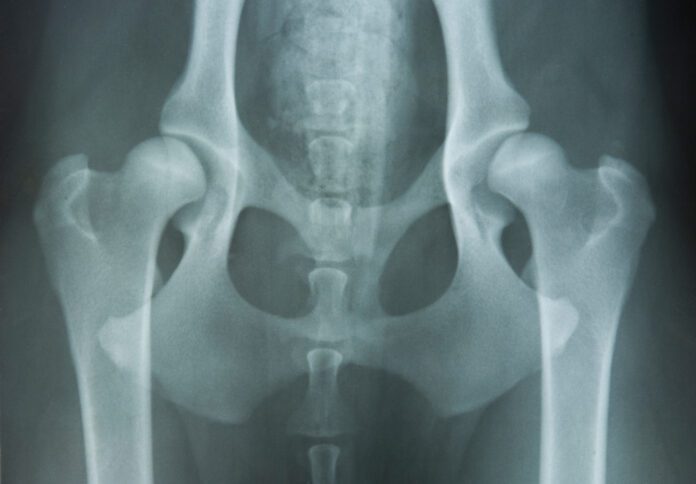
There are many orthopedic conditions that can affect our dogs, but the one that strikes fear in the hearts of most dog parents is hip dysplasia. With early detection, hip dysplasia can be successfully managed in puppies. Even dogs with arthritis secondary to hip dysplasia can have an improved quality of life with surgical intervention or medical management.
Causes | Signs | Diagnosis | Treatment
What is hip dysplasia in dogs?
Hip dysplasia is the malformation of the hip joint during a puppy’s growth period. The hip joint is composed of two parts: the head of the femur (ball) and the acetabulum (socket). This is why the hip is known as a ball and socket joint.
When a puppy grows, the head of the femur and the acetabulum need to grow at a uniform rate. This creates a snug fit of the ball within the socket. In hip dysplasia, the head of the femur and the acetabulum grow at different rates, creating laxity within the joint.
To demonstrate what this looks like, form a fist with your left hand. This represents the head of the femur. Now cup your right hand snugly over your fist. This represents the acetabulum. Rotate your fist inside of your cupped hand; this is how the ball of the hip moves naturally within the socket.
In a puppy or dog with hip dysplasia, the acetabulum does not fit snugly around the ball of the femur. Relax the fingers on your right hand so they are no longer snugly cupping your fist. Now rotate and move your fist within your right hand. Your fist has a lot more space to move around; this is analogous to the joint laxity in hip dysplasia.
When the ball sloshes around in the socket, the cartilage lining the ball collides with the cartilage lining the socket in unnatural ways. Over time, your dog’s body creates scar tissue along the edges of the cartilage to stabilize the hip joint. This scar tissue is not smooth like cartilage; it is bumpy and irregular.
A hip joint that is lined with scar tissue is known as an arthritic joint. Walking with an arthritic hip joint is painful. Your dog may exhibit periodic or chronic lameness. Dogs that live with a low level of chronic pain may not always exhibit lameness. But they will often have a shortened stride in their hind limbs or have atrophied thigh muscles because they cannot fully extend their hips.
What causes hip dysplasia in dogs?
Hip dysplasia is a hereditary condition that is influenced by several environmental factors during a puppy’s growth period. These factors include nutrition, exercise, and growth rate. Any breed of dog can be affected by hip dysplasia, although it is more commonly seen in large breed dogs such as German Shepherds, Labrador Retrievers, Golden Retrievers, and Saint Bernards.
Large breed puppies (any puppy that will weigh more than 50 pounds as an adult) should be fed a high-quality large breed puppy food. Puppy food that is formulated specifically for large breeds delivers a more controlled amount of calcium and protein to ensure proper bone development.
All puppies regardless of breed or size should be kept lean as they grow and not be allowed to gain excess weight. Being overweight puts additional strain on the hip joints and promotes joint laxity. The best way to ensure that your puppy grows at the correct rate is to feed two or three meals daily and follow your veterinarian’s recommendation on how much to feed at each meal.
Strenuous exercise in puppies, such as long hikes or going for long runs, can lead to premature excessive muscle development. This can contribute to laxity of the hip by changing the mechanical forces on the joint as it develops.
What are the signs of hip dysplasia in dogs?
Puppies who have hip dysplasia may walk with a bunny hop gait in their hind limbs. However, many puppies with hip dysplasia show no overt signs of lameness or gait abnormalities.
As dogs with hip dysplasia age and develop arthritic hip joints, they may show periodic lameness, a reluctance to use stairs, and may be slow to rise from a sitting or laying position. It is important to note that not all arthritic hip joints are caused by hip dysplasia. And the aforementioned signs can also be caused by osteoarthritis in joints other than the hips. Have your dog assessed by his veterinarian to determine the underlying cause of his discomfort and formulate a treatment plan.
How is hip dysplasia diagnosed?
The gold standard for diagnosing hip dysplasia is with radiographs (x-rays) of the hips. Your dog will require moderate to heavy sedation or even a brief period of anesthesia to complete these radiographs.

There are two radiographic methods for diagnosing hip dysplasia. One method involves completing a single radiograph of your dog’s hips while he is laying on his back with his hind limbs extended. This is called an extended ventrodorsal view of the pelvis. This radiograph can be interpreted by a board-certified veterinary radiologist or submitted to the Orthopedic Foundation for Animals (OFA) for analysis and certification.
The second method is a specialized set of radiographs called PennHIP (this stands for the University of Pennsylvania Hip Improvement Program). The PennHIP method requires three views of your dog’s hips. The first view is the extended ventrodorsal view discussed above and is used to detect if any arthritic changes are evident in the hip joints.
The second view simulates how the hip joints would appear if your dog were held up in a standing but non-weight bearing position. The third view simulates how your dog’s hip joints would appear if he were standing and bearing weight on his hind limbs. This is achieved through the use of a special positioning device for his hind limbs.
The extended ventrodorsal view of the pelvis is the most widely used radiographic method for diagnosing hip dysplasia. It can be done by any veterinarian and requires no special equipment or additional training. However, this method does not take into account the forces that apply pressure to the hips when a dog is standing. Therefore, the hips of some dogs with hip dysplasia may appear normal using this method. Also, this view may not be diagnostic in dogs who are less than 1 year old.
In contrast, the PennHIP method can be used to detect if a puppy is likely to develop hip dysplasia. This method can be used in puppies as young as 4 months old. Only veterinarians who have undergone specialized training can utilize the PennHIP method to screen for and diagnose hip dysplasia.
There is a simple palpation technique to screen for hip dysplasia that can be completed during a puppy’s wellness exam. This palpation technique, called the Ortolani Sign, tests for laxity of the hip joint. Light sedation may be required to relax the muscles around the hip (and to better control a wiggly puppy!).
A positive Ortolani Sign indicates the presence of hip dysplasia. However, some puppies with hip dysplasia may have a negative Ortolani Sign. The PennHIP method has been shown to be a more accurate screening tool for hip dysplasia in puppies as young as 4 months old.
Hip dysplasia in dogs treatment
There are two surgical options for puppies with hip laxity and two surgical options for dogs with hip dysplasia. Medical management is also an option for dogs who are unable to undergo surgery.

Puppies who have been diagnosed with hip laxity between 10 and 18 weeks of age may benefit from a surgical procedure called Juvenile Pubic Symphysiodesis (JPS). This simple procedure prematurely closes a growth plate in the bottom of the pelvis. Closing this growth plate causes the acetabulum to cup the head of the femur more as it grows over the next 4 to 6 months, minimizing joint laxity and the development of hip dysplasia. Puppies with hip laxity who are older than 18 weeks of age are not candidates for this procedure.
Puppies between 4½ and 10 months of age who have been diagnosed with hip dysplasia may benefit from a procedure called a double or triple pelvic osteotomy (DPO or TPO). In this surgical procedure, two or three cuts are made in the pelvis. Then the acetabulum is rotated so that it properly cups the head of the femur.
Only puppies with mild to moderate hip laxity qualify for the DPO or TPO procedure. Puppies with severe hip laxity, lameness, or evidence of arthritic changes to their hips on radiographs should not undergo a DPO or TPO.
Adult dogs with hip dysplasia have two surgical options to improve their quality of life and give them pain-free movement of their hips. These procedures are total hip replacement (THR) or femoral head osteotomy (FHO).
A total hip replacement involves replacing the femoral head and the acetabulum with metal and plastic implants. This is similar to the procedure that is done in humans. THR gives dogs with hip dysplasia the best possible chance to return to a normal and pain-free activity level.
The FHO procedure is the complete removal of the femoral head, or ball of the hip joint. No replacement ball is installed in the femur. Over the next few months after surgery, the dog’s body develops scar tissue around what remains of the hip joint to create a false joint. Removing the head of the femur eliminates the pain associated with the arthritic hip but does not allow for full range of motion of the hip joint. Dogs who undergo an FHO will be more comfortable and pain-free but will not be restored to their pre-arthritic activity level.
Medical management of hip dysplasia and the associated arthritis consists of light daily exercise, the use of a non-steroidal anti-inflammatory (NSAID) and other medications to treat pain, cartilage protectant supplements such as glucosamine and chondroitin, an omega-3 and omega-6 fatty acid supplement, and physical therapy.
Dogs with hip dysplasia should not be allowed to become overweight. Being overweight increases the strain on a dog’s arthritic hip joints. Talk with your veterinarian about an appropriate medical management plan for your dog.
With appropriate intervention and management, dogs with hip dysplasia can lead a relatively normal life. Early intervention is the key to maintaining pain-free mobility and an active lifestyle.






I have OFA’d my dogs since the early 90s and they have never been under any type of anesthesia. Any vet who requires it, find a different vet. There are plenty who will do it without. PennHip, yes, a different matter. Anesthesia, plus the grading is complicated if there aren’t enough dogs in the data base to compare to. Advantage with PennHip is that it can be done at a much younger age rather than wait till age two with OFA for certification.